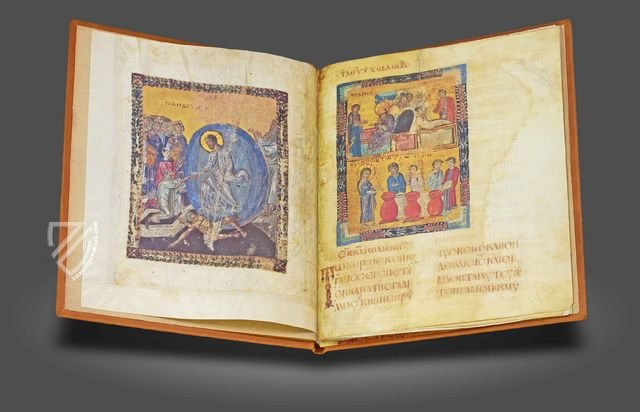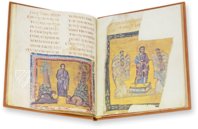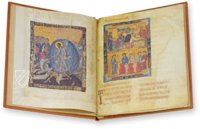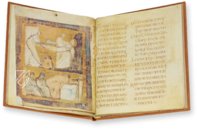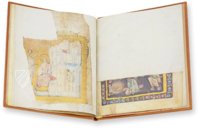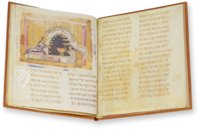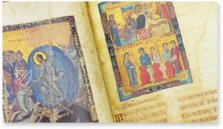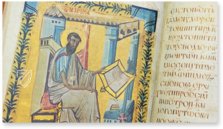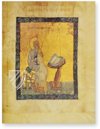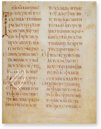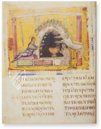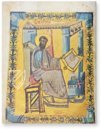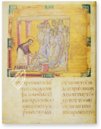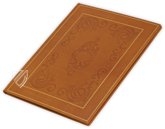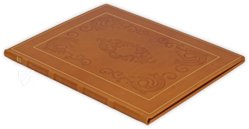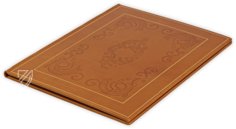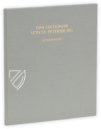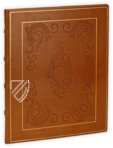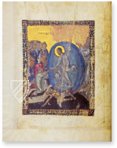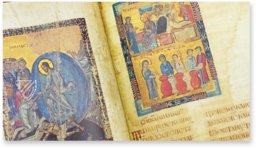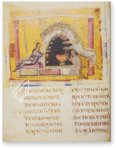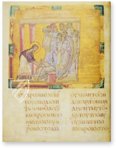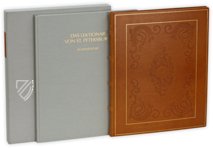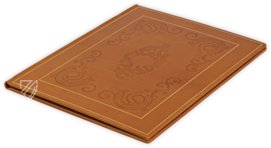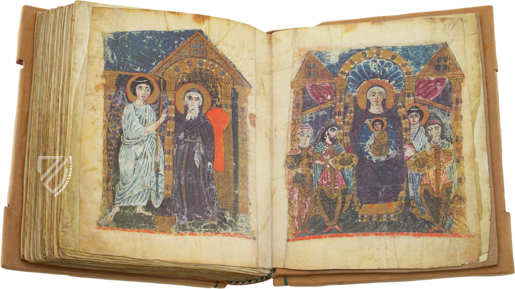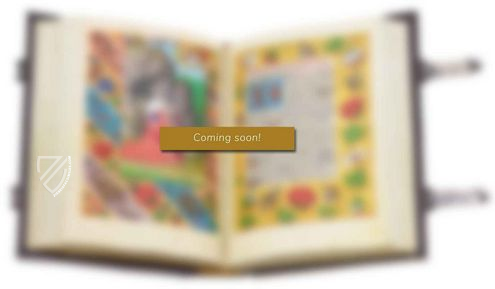Gospel Lectionary of Trebizond
(under 1,000€)
A truly beautiful Byzantine manuscript with a long and fascinating story: the Gospel Lectionary of Saint Petersburg. It is a mysterious manuscript with an eventful history which was long kept in Trebizond, at the intersection between two cultures on the rims of the Black Sea, the Byzantine and the Ottoman, through the troubled ages of the crusades and Ottoman conquests. The artistic style of the manuscript, employing typical Byzantine elements such as burnished gold backgrounds, displays both clear oriental influences and a strong tendency toward classicism. This 10th century manuscript was used continuously for centuries and as such, was badly worn before its restoration with many miniatures being nearly unrecognizable, but is now restored to its former glory.
Gospel Lectionary of Trebizond
The Gospel Lectionary of Saint Petersburg, also called the Gospel Lectionary of Trebizond, is considered a true jewel of Byzantine art. It is a mysterious manuscript with an eventful history which was long kept in Trebizond, at the intersection between two cultures on the rims of the Black Sea, the Byzantine and the Ottoman, through the troubled ages of the crusades and Ottoman conquests. The Golden Gospels, as it was also called for its rich gold embellishment, dates back to the 2nd half of the 10th century. Commissioned by an unknown patron, the rich use of gold and high-end craftsmanship indicate that it was made for a high ranking personality. In 1223, it was presented as a votive gift to the Virgin Mary by Andronikos Gidon in a cathedral which bore the name Gold-Headed Virgin, where it formed an integral part of Orthodox liturgy until the middle of the 15th century. The Gospel lectionary is valued above all for the great artistic quality of its miniatures. They are dispersed over nearly all the pages of the codex and illustrate individual episodes of the Gospels. The text, however, is written in Greek and is deserving great attention, as it is very old and grammatically astonishingly exact.
A Precious Treasure of Byzantine Art
The manuscript contains a total of 16 miniatures painted throughout in tempera on a golden ground to enhance their luminosity. The decorative apparatus is the work of several painters and displays both clear oriental influences and a strong tendency toward classicism. In line with the tradition of book illumination in the 10th century, the decoration contains a portrait of John the Evangelist in the classical style: John is presented as a classical philosopher, wearing a toga, and holding a scroll in his hands (folio 1r). The text is written in pale blue ink in liturgical uncial, a form of majuscule used in the 10th century. Some initials are especially highlighted through clear enlargement and the use of gold, cinnabar, blue and green. Neume notation was added at a later stage in a bright red color. As the Gospel lectionary was used in liturgy over long periods of time, it was until recently in a very bad state of preservation. The colors and the gold leaf of the grounds had peeled off in many places. A number of miniatures were almost entirely destroyed. The viewer can now admire this masterly work of art in its original state following its successful restoration.
A Profound Testimony to the Mysteries and Aesthetics of the Orthodox Church
The preserved text fragments of the Gospel Lectionary and the contents of the miniatures allow it to be ascribed to the tradition of typographic Gospel lectionaries, which** contained readings from the Gospels for each day, from Passion week and Easter down to Pentecost**. The book contains only Saturday and Sunday readings for all other weeks of the ecclesiastical year. In 1858, the precious Gospel Lectionary was presented to the Russian Tsar Alexander II as an aid for the construction of a church and thus moved to the collection of Greek manuscripts in the Imperial Library. The director of the library at the time proudly stated that "the Greek Gospels [takes] the most important place among the recent acquisitions of our library in the year 1858". The fragments from Trebizond were withdrawn from the Gospel lectionary to which they formerly belonged and finally bound separately. They have been kept in this leather binding ever since.
Codicology
- Alternative Titles
- Lektionar von St. Petersburg
Lectionary of St Petersburg
Golden Gospels
Trebizond Lectionary
Lectionary of Saint Petersburg - Size / Format
- 30 pages / 33.3 × 25.5 cm
- Origin
- Turkey
- Date
- 2nd half of the 10th century
- Epochs
- Style
- Genre
- Language
- Script
- Uncial
- Illustrations
- 13 mostly full-page miniatures, 3 fragments of miniatures, 3 elaborated initials
- Previous Owners
- Tsar Alexander II of Russia (1818–1881)
Gospel Lectionary of Trebizond
The Last Supper
This unusual depiction of the Last Supper is nonetheless probably one of the most historically accurate insofar as how a meal probably would have been consumed in the Roman world at the time. Before a weathered but beautiful gold background, Jesus and the Twelve Apostles are shown lounging on couches surrounding a long oblong table with a black surface. As was typical in Byzantine art, Judas is identified in the foreground grasping for the food as the other’s wait with outstretched hands.

Gospel Lectionary of Trebizond
Portrait of Mark the Evangelist
Presented before a timeless and spaceless background of gold leaf, this portrait of Mark the Evangelist is an extraordinary specimen of Byzantine illumination from the so-called Macedonian Renaissance. Despite exhibiting marks of use across ten centuries, this miniature page is preserved in remarkably good condition with minimal damage.
Dressed in a Roman toga, seated within a simple classical architecture, and surrounded by a frame of classically-styled acanthus leaves, this portrait of St. Mark is exemplary of the revival in classical forms and subjects that had been occurring in Byzantine art since the mid–9th century. At the same time, some stylistic innovations are observable, e.g. the stylishly angular fall of folds observable in Mark’s robes.
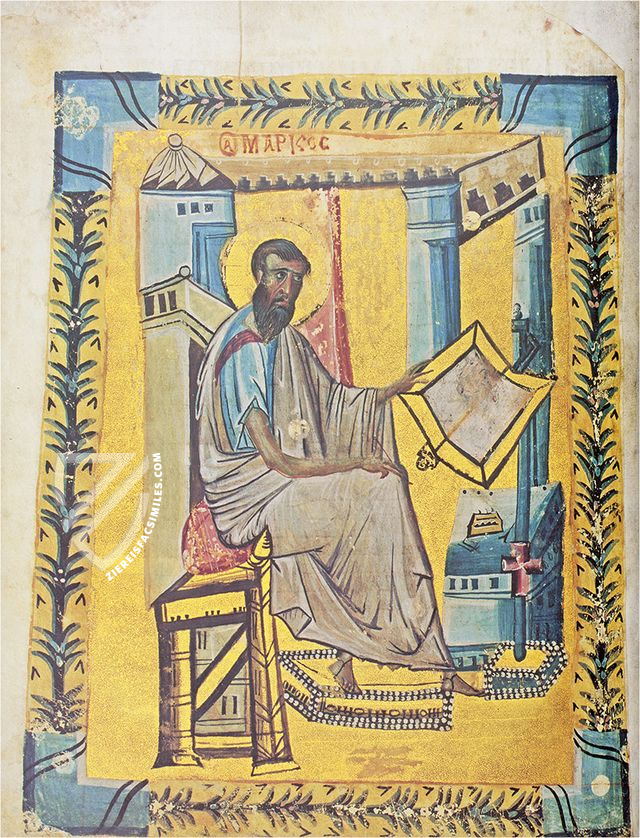
#1 Das Lektionar von St. Petersburg
Languages: German, English
(under 1,000€)
#2 Das Lektionar von St. Petersburg
Languages: German, English
Commentary and facsimile are combined in one volume.
(1,000€ - 3,000€)
- Treatises / Secular Books
- Apocalypses / Beatus
- Astronomy / Astrology
- Bestiaries
- Bibles / Gospels
- Chronicles / History / Law
- Geography / Maps
- Saints' Lives
- Islam / Oriental
- Judaism / Hebrew
- Single Leaf Collections
- Leonardo da Vinci
- Literature / Poetry
- Liturgical Manuscripts
- Medicine / Botany / Alchemy
- Music
- Mythology / Prophecies
- Psalters
- Other Religious Books
- Games / Hunting
- Private Devotion Books
- Other Genres
- Afghanistan
- Armenia
- Austria
- Belgium
- Colombia
- Croatia
- Cyprus
- Czech Republic
- Denmark
- Egypt
- Ethiopia
- France
- Germany
- Greece
- Hungary
- India
- Iran
- Iraq
- Israel
- Italy
- Japan
- Lebanon
- Luxembourg
- Mexico
- Morocco
- Netherlands
- Palestine
- Peru
- Poland
- Portugal
- Russia
- Serbia
- Spain
- Sri Lanka
- Sweden
- Switzerland
- Syria
- Turkey
- Ukraine
- United Kingdom
- United States
- Uzbekistan
- Aboca Museum
- Ajuntament de Valencia
- Akademie Verlag
- Akademische Druck- u. Verlagsanstalt (ADEVA)
- Aldo Ausilio Editore - Bottega d’Erasmo
- Alecto Historical Editions
- Alkuin Verlag
- Almqvist & Wiksell
- Amilcare Pizzi
- Andreas & Andreas Verlagsbuchhandlung
- Archa 90
- Archiv Verlag
- Archivi Edizioni
- Arnold Verlag
- ARS
- Ars Magna
- ArtCodex
- AyN Ediciones
- Azimuth Editions
- Badenia Verlag
- Bärenreiter-Verlag
- Belser Verlag
- Belser Verlag / WK Wertkontor
- Benziger Verlag
- Bernardinum Wydawnictwo
- BiblioGemma
- Biblioteca Apostolica Vaticana (Vaticanstadt, Vaticanstadt)
- Bibliotheca Palatina Faksimile Verlag
- Bibliotheca Rara
- Boydell & Brewer
- Bramante Edizioni
- Bredius Genootschap
- Brepols Publishers
- British Library
- C. Weckesser
- Caixa Catalunya
- Canesi
- CAPSA, Ars Scriptoria
- Caratzas Brothers, Publishers
- Carus Verlag
- Casamassima Libri
- Chavane Verlag
- Christian Brandstätter Verlag
- Circulo Cientifico
- Club Bibliófilo Versol
- Club du Livre
- CM Editores
- Collegium Graphicum
- Collezione Apocrifa Da Vinci
- Comissão Nacional para as Comemorações dos Descobrimentos Portugueses
- Coron Verlag
- Corvina
- CTHS
- D. S. Brewer
- Damon
- De Agostini/UTET
- De Nederlandsche Boekhandel
- De Schutter
- Deuschle & Stemmle
- Deutscher Verlag für Kunstwissenschaft
- DIAMM
- Droz
- E. Schreiber Graphische Kunstanstalten
- Ediciones Boreal
- Ediciones Grial
- Ediclube
- Edições Inapa
- Edilan
- Editalia
- Edition Deuschle
- Edition Georg Popp
- Edition Leipzig
- Edition Libri Illustri
- Editiones Reales Sitios S. L.
- Éditions de l'Oiseau Lyre
- Editions Medicina Rara
- Editorial Casariego
- Editorial Mintzoa
- Editrice Antenore
- Editrice Velar
- Edizioni Edison
- Egeria, S.L.
- Eikon Editores
- Electa
- Emery Walker Limited
- Enciclopèdia Catalana
- Eos-Verlag
- Ephesus Publishing
- Ernst Battenberg
- Eugrammia Press
- Extraordinary Editions
- Fackelverlag
- Facsimila Art & Edition
- Facsimile Editions Ltd.
- Facsimilia Art & Edition Ebert KG
- Faksimile Verlag
- Feuermann Verlag
- Folger Shakespeare Library
- Franco Cosimo Panini Editore
- Friedrich Wittig Verlag
- Fundación Hullera Vasco-Leonesa
- G. Braziller
- Gabriele Mazzotta Editore
- Gebr. Mann Verlag
- Gesellschaft für graphische Industrie
- Getty Research Institute
- Giovanni Domenico de Rossi
- Giunti Editore
- Graffiti
- Grafica European Center of Fine Arts
- Guido Pressler
- Guillermo Blazquez
- Gustav Kiepenheuer
- H. N. Abrams
- Harrassowitz
- Helikon
- Hendrickson Publishers
- Henning Oppermann
- Herder Verlag
- Hes & De Graaf Publishers
- Hoepli
- Holbein-Verlag
- Hortus Deliciarum
- Houghton Library
- Hugo Schmidt Verlag
- Idion Verlag
- Il Bulino, edizioni d'arte
- ILte
- Imago
- Insel Verlag
- Instituto Nacional de Antropología e Historia
- Istituto dell'Enciclopedia Italiana - Treccani
- Istituto Ellenico di Studi Bizantini e Postbizantini
- Istituto Geografico De Agostini
- Istituto Poligrafico e Zecca dello Stato
- Italarte Art Establishments
- J. Thorbecke
- Jan Thorbecke Verlag
- Johnson Reprint Corporation
- Josef Stocker
- Josef Stocker-Schmid
- Jugoslavija
- Karl W. Hiersemann
- Kasper Straube
- Kaydeda Ediciones
- Kindler Verlag / Coron Verlag
- Kodansha International Ltd.
- Konrad Kölbl Verlag
- Kurt Wolff Verlag
- La Liberia dello Stato
- La Linea Editrice
- La Meta Editore
- Lambert Schneider
- Landeskreditbank Baden-Württemberg
- Leo S. Olschki
- Les Incunables
- Library of Congress
- Libreria Musicale Italiana
- Lichtdruck
- Lito Immagine Editore
- Lumen Artis
- Lund Humphries
- M. Moleiro Editor
- Maison des Sciences de l'homme et de la société de Poitiers
- Manuscriptum
- Martinus Nijhoff
- Maruzen-Yushodo Co. Ltd.
- MASA
- McGraw-Hill
- Militos
- Millennium Liber
- Müller & Schindler
- Nahar and Steimatzky
- National Library of Wales
- Neri Pozza
- Nova Charta
- Oceanum Verlag
- Odeon
- Orbis Mediaevalis
- Orbis Pictus
- Österreichische Staatsdruckerei
- Oxford University Press
- Pageant Books
- Parzellers Buchverlag
- Patrimonio Ediciones
- Pattloch Verlag
- PIAF
- Pieper Verlag
- Plon-Nourrit et cie
- Prestel Verlag
- Princeton University Press
- Prisma Verlag
- Priuli & Verlucca, editori
- Pro Sport Verlag
- Propyläen Verlag
- Pytheas Books
- Quaternio Verlag Luzern
- Reales Sitios
- Recht-Verlag
- Reichert Verlag
- Reichsdruckerei
- Riehn & Reusch
- Roberto Vattori Editore
- Rosenkilde and Bagger
- Roxburghe Club
- Salerno Editrice
- Sarajevo Svjetlost
- Schöck ArtPrint Kft.
- Scolar Press
- Scrinium
- Scripta Maneant
- Scriptorium
- Siloé, arte y bibliofilia
- SISMEL - Edizioni del Galluzzo
- Sociedad Mexicana de Antropología
- Société des Bibliophiles & Iconophiles de Belgique
- Soncin Publishing
- Sorli Ediciones
- Stainer and Bell
- Studer
- Styria Verlag
- Sumptibus Pragopress
- Szegedi Tudomànyegyetem
- Taberna Libraria
- Tarshish Books
- Taschen
- Tempus Libri
- Testimonio Compañía Editorial
- Thames and Hudson
- The Clear Vue Publishing Partnership Limited
- The Facsimile Codex
- The Folio Society
- The Marquess of Normanby
- The Richard III and Yorkist History Trust
- Tip.Le.Co
- TouchArt
- TREC Publishing House
- TRI Publishing Co.
- Trident Editore
- Typis Regiae Officinae Polygraphicae
- Union Verlag Berlin
- Universidad de Granada
- University of California Press
- University of Chicago Press
- Urs Graf
- Vallecchi
- Van Wijnen
- VCH, Acta Humaniora
- VDI Verlag
- VEB Deutscher Verlag für Musik
- Verlag Anton Pustet / Andreas Verlag
- Verlag Bibliophile Drucke Josef Stocker
- Verlag der Münchner Drucke
- Verlag für Regionalgeschichte
- Verlag Styria
- Vicent Garcia Editores
- W. Turnowsky
- Waanders Printers
- Wiener Mechitharisten-Congregation (Wien, Österreich)
- Wissenschaftliche Buchgesellschaft
- Wydawnictwo Dolnoslaskie
- Xuntanza Editorial
- Zakład Narodowy
- Zollikofer AG

